Serengeti Migration Safari
The Great Serengeti Migration Safari Experience is the best Safari experience in the Northern Tanzania. The Great Wildebeest Migration in the Serengeti is the largest single movement of wild animals in the world, deservedly listed as one of its eight Natural Wonders and an exceptional inspiration for a dream nature tour of northern Tanzania with Nature Horizons Tours. Around 1.5 million wildebeests, with hundreds of thousands of zebras, elands, gazelles along with a trailing retinue of predators, leave their calving grounds in southern Serengeti, around March and April, heading for the next water source. Trekking via the south-central Seronera outskirts into the Western Corridor and Grumeti River arriving during the month of April to May and residing till June, and then finally towards the Masai Mara National Reserve in Kenya crossing the perilous Mara River around July or August onwards with a return via the same death-defying river, this time heading to the bearing of Lobo and Loliondo in eastern Serengeti around October to November. The white bearded wildebeest journey continues back to the southern Ndutu calving grounds with arrivals starting around December with temporary residence till March.
Best time to Visit
We can find the main calving grounds in the area southeast of Seronera: typical Serengeti plains stretch all the way to the Ndutu area near Ngorongoro. Triggering their move to this area are the short rains in November and December. The wildebeest stick around this area until the end of the long rains, end of April, early May. The delightful news is that this section of Serengeti National Park is easily accessible and that in this period the landscape becomes lush. February is usually calving season in the Ndutu area and the southeastern plains: the very best time to visit this area. As wildebeest, zebra and other ungulates are so many, and give birth to so many calves, the spectacle works as a magnet for predators. As early as March or April the herd may move again in search of greener pastures. Seeing the actual migration in this period is more difficult, but chances are that you will encounter very large herds on the move.
This is the period that the wildebeest, after having feasted on the short green grasses of the southeastern Serengeti and after having giving birth to their offspring, start getting ready for their 800 kilometer long trek. The actual starting date may be anytime between late April and early June. This is the time to you may have the privilege to see one of the greatest natural phenomena in the world: more than a million marching animals in a column up to 40 kilometers long. During the migration, the herd will move towards the Western Corridor, where they will face the first major obstacle: crossing the Grumeti River. Many animals don’t survive the crossing as they are being awaited by the area’s population of oversized crocodiles ready to feast. The herd may congregate on the southern bank of the river and stay there for up to two weeks before crossing the river.
When the Grumeti River obstacle has been taken, the herd moves further north and starts crossing the next big hurdle, the Mara River, in July or August. The Mara River crossing is where so many iconic Great Migration photos have been taken. After this crossing the herd flocks to the northwest plains and Masai Mara National Reserve in Kenya. The August – September period is considered being a bad time to visit Serengeti National Park and see the Great Migration as the herd moves into the Masai Mara in Kenya. However, migration patterns show that about half of the herd stays on the Tanzanian side, in the Mara Serengeti area. In this period, smaller herds of wildebeest (well consider small… herds may count up to between 500 and thousands of individuals) frequently cross the Mara River, back and forth, for no apparent reason. This is an excellent time to stay at one of the Serengeti Mara camps.
Crossing the Mara River northbound means that, at one point, the herd needs to cross the river one more time before commencing the trek back in a southerly direction. This usually happens in October, but sometimes earlier. In this period the herd will cross the northern plains and Lobo area. This section of Serengeti National Park is little-visited, so if you are looking to see the migration in relative quietness, this would be the time. The wildebeest return to the short- grass plains and calving ground around Ndutu in late November. And from here, the Great Migration starts all over again.

TANZANIA UNFORGETTABLE ADVENTURES
Book Serengeti Safari with Us..
Browse our recommended Wildebeest Migration safaris
Natural phenomena occur all over the world, but very few can compete with the sheer size of the annual Wildebeest Migration through the Serengeti-Mara Ecosystem. The numbers alone are hard to believe: up to 2 million animals – wildebeest as well as zebra and gazelle – follow the rains and their ancient instincts on a death-defying, 3 000-kilometre (1 900-mile) journey. It’s drama on a truly epic scale: the migrating herds undergo all manner of challenges and hardships as they move from region to region. They’re constantly under attack from predators, none more so than from Africa’s big cats – lion, leopard and cheetah – and the massive crocodiles that lie in wait at various river crossing points.




